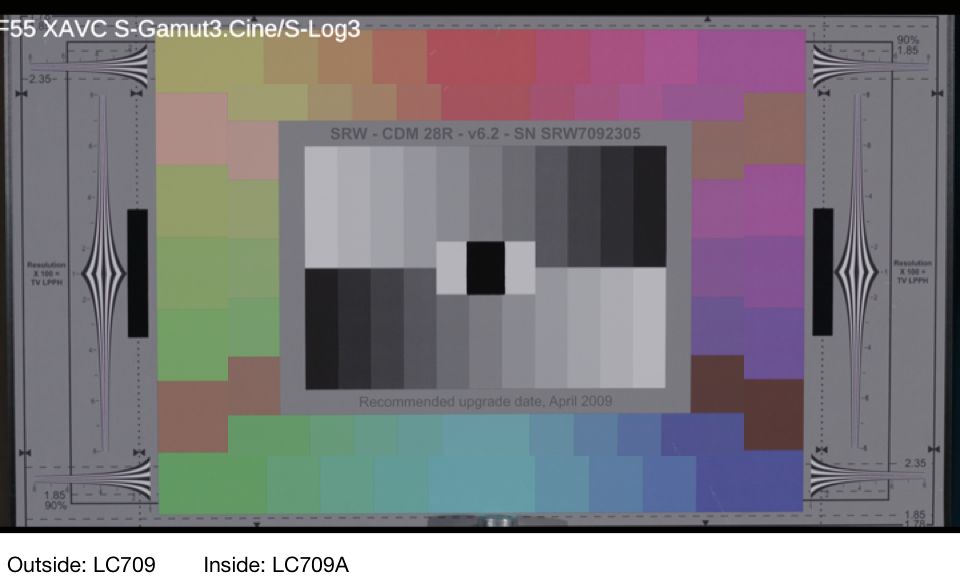
#Lutcalc art adams lc709a iso
Adding 100K steps between 4300K and 5500K, for example, would require 27 LUTs at one ISO setting alone.Ĭustom mode-the alternative to Cine-EI-appears to use a simple color matrix to bend the camera’s color space into Rec 709. There’s only so much space to do that, and only so much time a company is willing to spend calculating such things. This makes sense, as Sony states the reason they don’t offer white balancing options in Cine-EI mode is because the camera’s color gamut is so immense, and the color science math is so complex, that they have to generate a new LUT for each new white point (and presumably for each ISO) and that has to be stored in the camera’s memory.

cube files: all three LUTs were different, which tells me that white balance definitely makes a difference when generating a LUT. As a test I exported all three presets at the same ISO and took a peak inside the resulting. There’s one big caveat, though: I have to generate a new ISO LUT for each of Sony’s white balance presets (3200K, 4300K and 5500K). In Sony Raw Viewer I simply set exposure compensation in precise 1/3 stop increments. How do I create a LUT in Resolve that exactly compensates for a one stop ISO change? It’s not easy. It allows me to generate LUTs that perfectly compensates for exposures at non-native ISOs. It's one of the best designed OEM camera apps I've seen. If this tool is so wonky, why use it? Because it's not that wonky. Don't think of where the ISO slider itself lands, as that won't make any sense. It’s up to you to make the correction by adjusting the exposure control, and it’s best to look only at the window to the right of the slider and set the exposure compensation in f/stops.

It will always show you, and assume you shot at, the camera’s native ISO, regardless of what metadata it detects and displays. The thing to remember is that Raw Viewer will show you the ISO metadata but won’t actually apply that ISO to the clip. I shot this image at ISO 1000, not ISO 500-so why should I have to reset the Exposure slider to -1? I have no idea. Pulling the slider to the left, until the exposure window at the right side says “-1”, makes the image look the way I shot it: In this case the Exposure slider says “1000” but the clip appears overexposed by one stop because Sony Raw Viewer is displaying it at ISO 2000, which is what Sony considers to be the FS7's optimal rating. One of this program’s quirks is that the Exposure slider will always show the ISO at which the clip was shot, but the thumbnail shows the clip at the camera’s native ISO. This is an ISO 100 shot brought into Sony Raw Viewer. When applied to that clip in post, that LUT will compensate for my ISO change and make the image look the way I want it to. I drag the exposure slider left until the window at the far right says “-1”, and then I export a LUT. If that clip was rated at ISO 1000 then it will appear to be one stop too bright. There’s an exposure slider at the top right of the interface that’s calibrated in f/stops, and selecting a clip causes that slider to default to the ISO it finds in the clip’s metadata. I start with a random clip that I captured with an FS7 at its native ISO and open it up in the viewer. My workaround is to generate post LUTs using Sony Raw Viewer. There’s no metadata that says, “Move middle gray up a stop, will you please?” If I’ve rated a camera a stop slower then my images will look a stop brighter when the standard LC709 Type A LUT is applied in post. If I provide post with S-Log3 files, however, I run into a problem: regardless of what ISO I’ve set on the camera, the log image is always recorded at the camera’s base ISO. I only shoot with those cameras in Cine-EI mode, typically with the LC709 Type A LUT engaged, and if I bake in a look then there’s no question that post will base their grade on what I’ve given them as they can only do minor tweaks. The F5 and FS7 I rate at ISO 1000 instead of 2000. I rate Sony’s F55 at ISO 640 instead of 1250. My rule of thumb is to divide the recommended base ISO by two, particularly when shooting visual effects projects, although there are better ways to determine a camera’s acceptable ISO.

They’re always a bit optimistic for my taste. There are compromises involved, and some of these revolve around the fact that these three cameras operate in huge color spaces.
#Lutcalc art adams lc709a free
Later I discovered that this was not a free ride. Finally I could use Sony cameras and not be repulsed by bright, saturated colors, orange flesh tones and abrupt roll-off in electronic-looking highlights. When Cine-EI mode became an option in the FS7/F5/F55 cameras I was pleasantly surprised, and when they released the LC709 Type A LUT I was ecstatic. I can’t stand the traditional “Sony look.” Hypergammas and Sony’s Custom-mode Rec 709 color matrices just don’t do it for me.


 0 kommentar(er)
0 kommentar(er)
